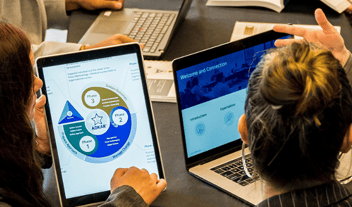How to Effectively Build Out a Role Roster for Change
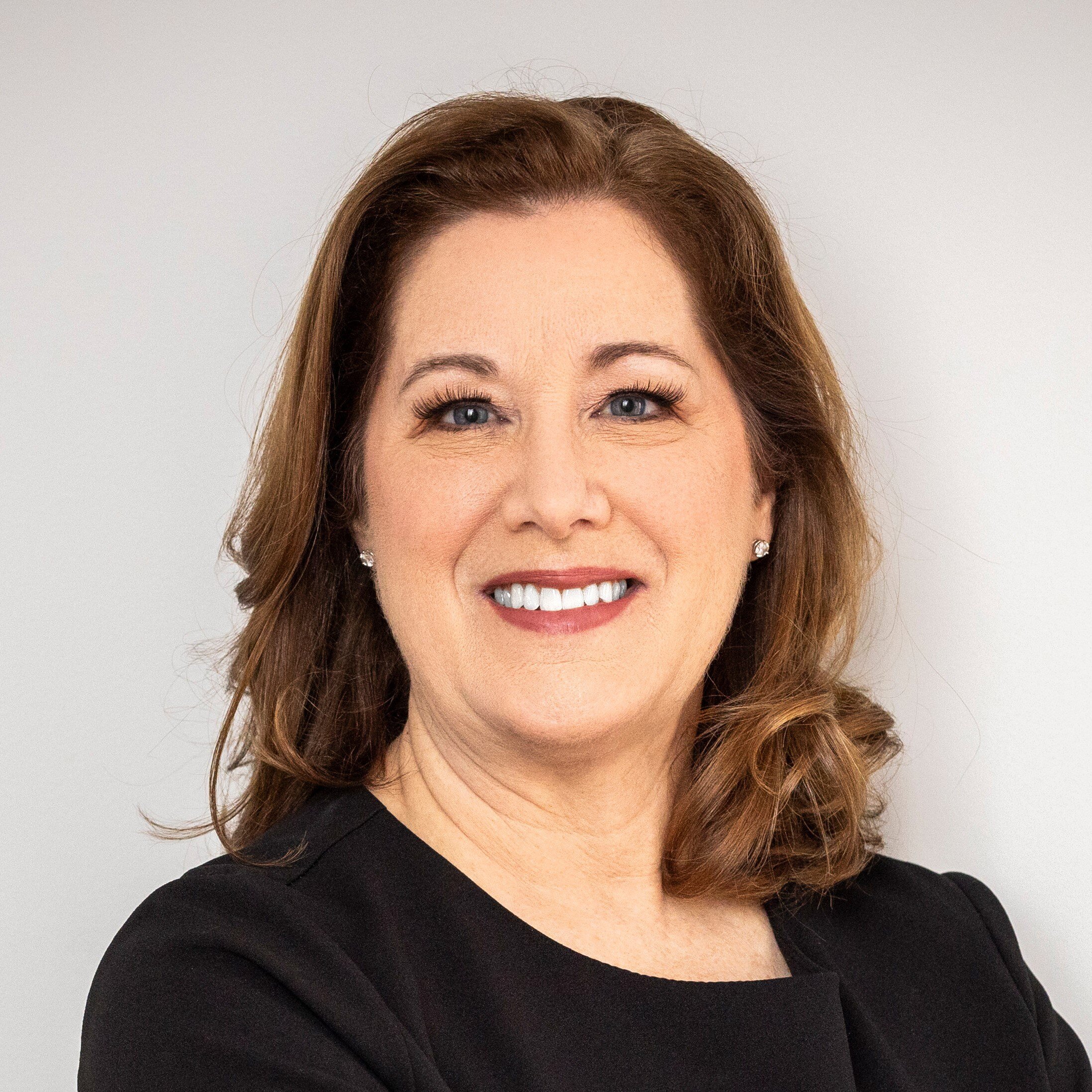
4 Mins
Updated: August 5, 2024
Published: July 6, 2022

Who does what during a change? As a change practitioner, how can you help these individuals actively fulfill their roles to ensure change success? These are questions you answer every time you embark on a new change. Building a role roster can help address these questions by providing clarity on critical change roles for a specific project and the people filling those roles. A well-designed role roster focuses attention on adoption and usage outcomes for each role and will improve your effectiveness and efficiency as a change practitioner.
Roles in Change Management
In the discipline of change management, we make the distinction between employee-facing roles and enabling roles, and how they work together as a system to support people through change. The enabling roles include change practitioners and project managers who apply structure to the change, design and develop the solution, and conduct other activities that set up the employee-facing roles for success. The employee-facing roles are the executive sponsors and people managers who leverage the ABCs and CLARC to move project changes forward.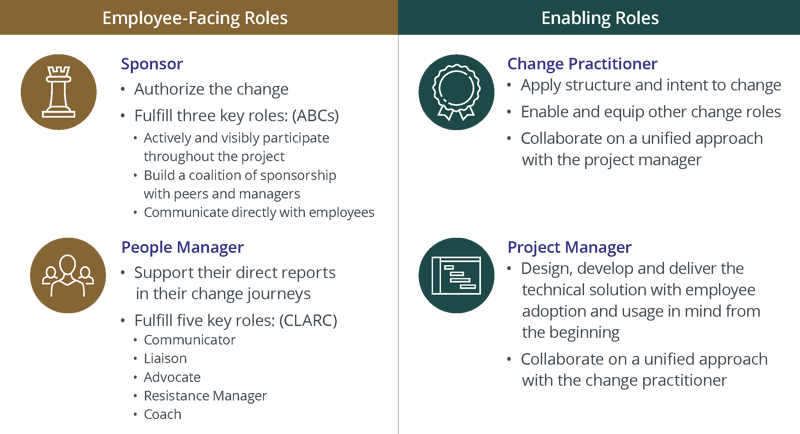
Understanding the differences in these roles is the first step to assembling the right team during change. When you consider the slide above, it is easy to see why change management does not equal communications and training.
Steps For Building a
Change Management Role Roster
When we help individuals fulfill their employee-facing roles, we can all drive greater adoption and usage, improve project success rates, and boost ROI. Following the steps below offers a straightforward and systematic approach.
1. Create role definitions
To identify the right people and put them in the right roles, we must clarify their unique contributions. You can do this by generating employee-centered role definitions or what Prosci calls the “I-by” statement:
“I, __________, contribute to successful change outcomes (through adoption and usage) by __________.”
Here is an example of an “I-by” statement for sponsors, in which we clarify by leveraging the ABCs of sponsorship:
“I, the primary sponsor, contribute to successful change outcomes through adoption and usage by actively and visibly participating, building coalitions and communicating directly.”
You can create a role-specific “I-by” statement for every role in change. This includes manager roles (using CLARC), change practitioners, project managers, solution developers, subject matter experts—everyone who has a role in the change. And this is especially helpful when clarifying roles for the people who are directly impacted by the change—those employees who must engage with, adopt and use the change.
Writing an “I-by” statement for each role involved in your change provides context for the roles based on their relationship to the impacted employees. It also clarifies any confusion about terms, purpose and outcomes for each role, and how they work together in change. Sometimes your organization uses a term one way, but it means something else to external users. Maybe you say, “change agent” and they say, “change champions.” When you create “I-by” statements, it helps everyone talk about the behaviors for adoption and usage the same way.
2. Assess barriers with the ADKAR Model
Once you identify which roles you need for your change, as well as who will fulfill each role, you can then build out your role roster. The roles needed and the time required of each depends on your project. Also, note that you may only need one person to play multiple roles or multiple people may be needed to play one key role.
The roster may also be dependent upon how much time commitment you need at various stages of the project. A project management role or ‘”technical side” role will have more work during planning and project initiation, but their activities might drop off later as you implement the change, approach go-live, start to reinforce behaviors, and sustain change outcomes. 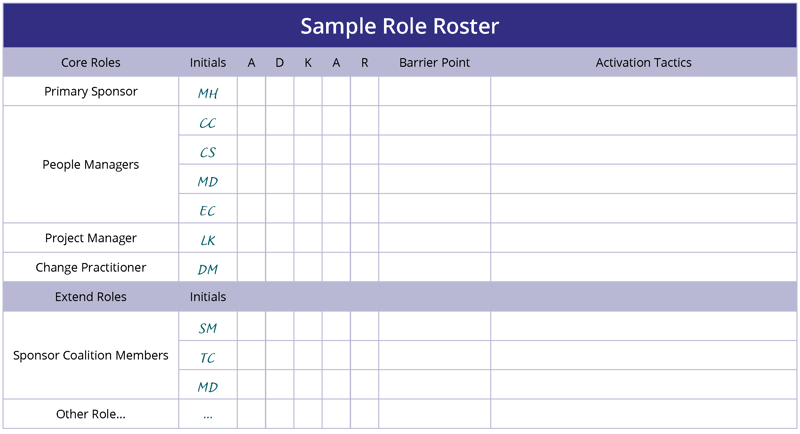 After identifying and clarifying each role, and understanding the time commitments, you must understand where individual barriers to change exist by leveraging the ADKAR Model. To be clear, this is not ADKAR for the project or change initiative. It’s ADKAR for role activation—for an assigned change role within your role roster. That may seem quite different from your usual ADKAR practices, but it's just another application of the individual process of change to get from current-state behaviors to future-state behaviors.
After identifying and clarifying each role, and understanding the time commitments, you must understand where individual barriers to change exist by leveraging the ADKAR Model. To be clear, this is not ADKAR for the project or change initiative. It’s ADKAR for role activation—for an assigned change role within your role roster. That may seem quite different from your usual ADKAR practices, but it's just another application of the individual process of change to get from current-state behaviors to future-state behaviors.
Barrier points occur in different places along an individual’s ADKAR journey. Often, the people you are working with don’t completely understand how to fulfill their role successfully, so we must help them by giving them coaching, training, feedback, time to build their skills—whatever they need to overcome their barriers to fulfilling their role in change.
To illustrate, consider the sponsor role. If you do an ADKAR assessment for the individual fulfilling the role of primary sponsor, you might arrive at a barrier point at Knowledge. Remember, this is Knowledge about how to fulfill the role of primary sponsor. This barrier point may exist because nobody has ever coached the individual on the ABCs of effective sponsorship.
To remedy a barrier point at Knowledge, you can schedule a sponsor briefing, perhaps with whole senior leadership team because others may also have this barrier point. We could also provide data on the importance of the sponsor role. For example, we know from our Best Practices in Change Management research that the number one indicator of successful projects is an active and visible sponsorship. We also know from our research that sponsors and senior leaders are preferred senders of organizational messages, which highlights the importance of their role as communicators. 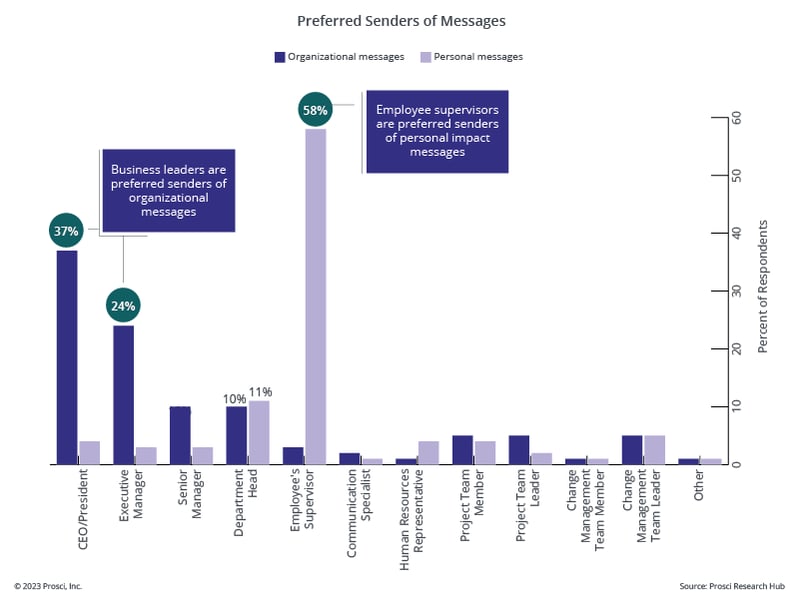
3. Activate your change roles
Your role as a change practitioner is to help the employee-facing individual succeed in their change role. In the case of a sponsor, you could build a sponsor roadmap or a sponsor plan. Explain where they need to be and when during the change process. Offer talking points for connecting with specific groups. Ensure that they are active with and visible to impacted audiences. Lay out the entire plan for them, so they can fulfill their role of effective sponsorship.
Note that what you do to activate each role depends on the role itself. So, the ABCs are not specific to a change, they're specific to the role of sponsors. CLARC is not specific to a change but to the role of people managers.
Effectively Activate Roles in
Change Management
The change practitioner’s role is to stand on the side of the stage behind the curtain while the main actors are on stage fulfilling their audience-facing roles effectively. By identifying the right people, putting them in the right roles, and activating their unique contributions, you can produce the desired outcomes of any change. Even better, activating change roles effectively today helps individuals in your organization become better at their critical roles for every change you will experience in the days and months ahead. It's a great way to economize your efforts.


